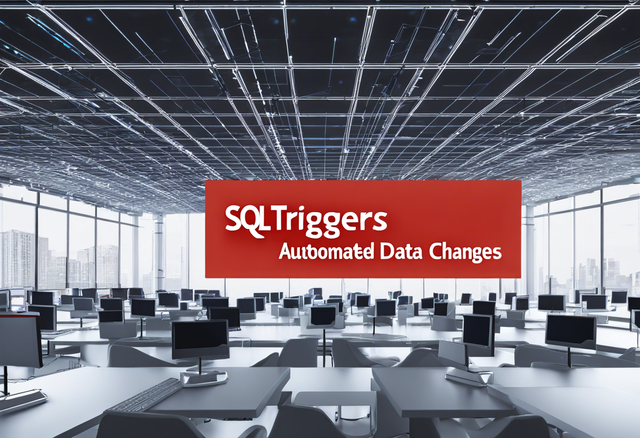SQL Triggers: Automated Actions on Data Changes
 Dishant Singh
Dishant Singh
In the dynamic realm of database management, where data is constantly evolving, ensuring data integrity, consistency, and adherence to business rules is paramount. Enter **SQL triggers**, powerful database objects that act as vigilant guardians, automatically executing predefined actions whenever specific data modifications occur within a table. This enables you to enforce complex business logic, maintain data integrity, and automate tasks without manual intervention.
Understanding the Essence of SQL Triggers
Imagine a scenario where you need to update the inventory count whenever a new product is added to your database. Or perhaps you want to log every change made to sensitive customer data for auditing purposes. This is where **SQL triggers** shine. They provide a robust mechanism to respond to data manipulation events, such as:
INSERT: When a new row is added to a table.
UPDATE: When an existing row is modified.
DELETE: When a row is removed from a table.
When a trigger is activated by one of these events, it executes a specified set of SQL statements, effectively automating actions based on the data change.
The Anatomy of a SQL Trigger
A **SQL trigger** is composed of several key elements:
Name: A unique identifier to distinguish the trigger from others.
Table: The table on which the trigger is defined.
Event: The specific data manipulation event (INSERT, UPDATE, DELETE) that triggers the action.
Timing: When the trigger should execute, either before the event (BEFORE) or after the event (AFTER).
Action: The set of SQL statements to be executed when the trigger is activated.
Types of Triggers
**SQL triggers** can be broadly categorized into two types:
Row-Level Triggers: These triggers are activated for each row that is affected by the triggering event. They provide granular control over individual rows.
Statement-Level Triggers: These triggers are activated only once for the entire triggering statement, regardless of the number of rows affected. They offer a more general approach to data manipulation events.
Creating SQL Triggers
Let's delve into the practicalities of creating **SQL triggers** using a concrete example. Consider a simple database with a table named "Products" to store product details.
<iframe src="https://sqlcompiler.live/embed?code=CREATE TABLE Products ( ProductID INT PRIMARY KEY, ProductName VARCHAR(255), Price DECIMAL(10,2) );
INSERT INTO Products (ProductID, ProductName, Price) VALUES (1,
In this example, we define a trigger named "PriceValidation" that executes before any new product is inserted into the "Products" table. The "FOR EACH ROW" clause specifies that the trigger should be activated for each row being inserted. The SQL statement within the trigger checks if the "Price" value of the new product exceeds $1000. If it does, the trigger signals an error, preventing the invalid insertion.
Benefits of Using SQL Triggers
**SQL triggers** offer a multitude of benefits for database management:
Enforce Business Rules: They can enforce complex business logic, ensuring data integrity and compliance with predefined rules.
Data Integrity: They help maintain data consistency by validating data changes before they are committed to the database.
Auditing and Logging: They can capture data changes, providing a detailed audit trail for security and compliance purposes.
Data Synchronization: They can be used to synchronize data across multiple tables or databases.
Automation: They automate tasks based on data modifications, eliminating manual intervention and reducing errors.
Important Considerations
While **SQL triggers** provide powerful capabilities, it's crucial to use them judiciously, keeping these considerations in mind:
Performance Impact: Triggers can affect database performance, especially if they involve complex logic or extensive data manipulation.
Complexity: Overly complex triggers can be difficult to understand and maintain, increasing the risk of errors.
Dependencies: Triggers can create dependencies between tables, making database changes more challenging.
Security Risks: Misconfigured triggers can expose the database to security vulnerabilities.
Real-World Use Cases of SQL Triggers
**SQL triggers** find application in various real-world scenarios, including:
Inventory Management: Updating inventory levels when products are ordered or returned.
Financial Systems: Auditing changes to financial transactions and generating reports.
E-commerce: Tracking customer orders and updating order status.
Social Media: Notifying users about new posts or messages.
Healthcare: Maintaining patient records and ensuring data privacy.
Conclusion
**SQL triggers** are indispensable tools in the database administrator's toolkit, empowering them to automate actions, enforce business rules, and maintain data integrity. By carefully designing and implementing triggers, you can enhance your database's reliability, efficiency, and security. As you delve deeper into the world of database management, embrace the power of **SQL triggers** to optimize your data operations.
Want to code Online SQL Commands:
Subscribe to my newsletter
Read articles from Dishant Singh directly inside your inbox. Subscribe to the newsletter, and don't miss out.
Written by
Dishant Singh
Dishant Singh
Hello,I am a full stack web developer known for transforming ideas into stunning, interactive digital experiences. With a rich portfolio of successful projects, I specialize in creating visually appealing and highly functional websites.